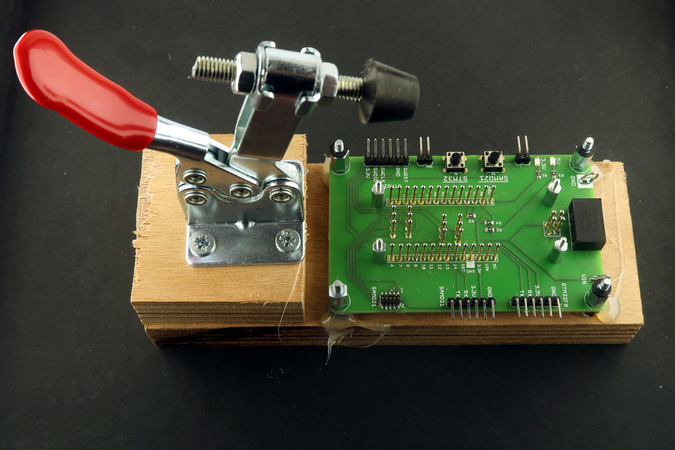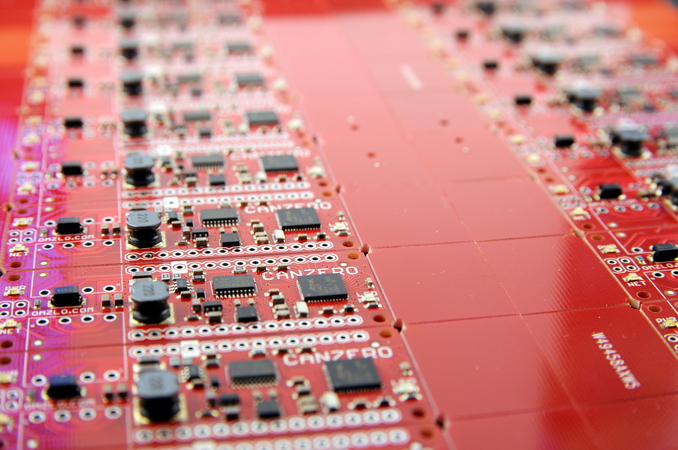In July 2018, our NoCAN Kickstarter campaign was successfully funded. NoCAN offers a novel 'wired' IoT platform for makers, as an alternative to 'wireless' approaches.
Of course, getting funded was just the beginning. We needed to get 675 boards produced and delivered to backers by September. In the end, we missed our deadline by a few weeks as our delivery schedule slipped into October, but we are happy overall for this success!
In this process, we learned a lot. So here are a few takeaways from this experience.
Testing is key
One of the nice features of the CANZERO is the fact that it uses two MCUs: a SAMD21 as the main 'Arduino-compatible' MCU and an STM32F0 as a CANbus network driver. The STM32F0 can be instructed to reset the SAMD21 in case of a programming error that causes the SAMD21 to lock-up for example. The disadvantage of this approach is that it doubles the amount of firmware programming and testing.
If testing a board takes 10 minutes, testing 600 boards will take 50 hours. That's a full week of work, with no pause or no mistakes. Reducing test time down to two minutes, or even one minute means a huge benefit.
To achieve fast testing, you need automation.
It took us a while to fine-tune this process. Here's basically how it works today for CANZERO boards:
- We put the board on a test jig with pogo pins and an internal testing circuit.
- The test jig is connected simultaneously to:
- An STM32 SWD programmer
- A SAMD21 SWD programmer
- A NoCAN network controlled by a Raspberry-Pi with a PiMaster
- A serial TTL cable connected to a computer
- A script then performs the following actions:
- Upload the STM32F0 firmware
- Upload a test program on the SAMD21, which tests all voltage levels and pins of the board and outputs the results to the serial line.
- Upload the default application and bootloader to the SAMD21.
- Upload the default application a second time over the NoCAN network. Any failure causes the process to stop, and the tested board is automatically disconnected from power.
The picture below shows our CANZERO torture jig!

For the PiMaster, our test jig was basically a small board with a 40 pin GPIO header connected to a Raspberry-Pi with an IDC ribbon cable. This made it easy to connect and disconnect the PiMaster, but it is not as efficient as the CANZERO jig. We are now in the process of creating a better setup for the PiMaster as well.
Boards will fail
When you make hundreds of boards, some will fail.

In our case, about 4% of boards failed to pass our full test. Luckily, more than half of these failures turned out to be very easy to fix with some minor rework. Yet, no matter how simple it is, rework takes time.
And this is time we could have used to put stamps on packages...
Shipping from Greece sucks
Omzlo is based in Greece. We have great weather but the postal system is from the '80s. And there is no way to purchase and print shipping labels yourself. More modern services like DHL or UPS are prohibitively expensive.
So we used good old stamps. Lots of stamps. Lots of time putting stamps on packages.
It's boring, believe us.

After the Kickstarter
Following our successful Kickstarter, Omzlo was incorporated as a company in August.
We will open our online store in a few days and give everyone a chance to build a NoCAN network!
A big thanks again to all backers who made this possible!
To stay updated on the NoCAN project, don't forget to follow us on Twitter or on our Facebook page.

Comments
19 comments triggered our SPAM filter and will be reviewed before publication.
Leave a comment